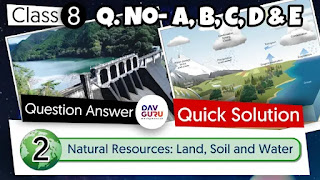All the available study materials for this chapter are listed below. Watch, download, and start studying!
Watch All Videos of This Chapter from PLAYLIST
A. Tick the correct option.
1. Which type of erosion leads to desertification?
(a) soil erosion ✅
(b) wind erosion
(c) water erosion
(d) wave erosion
2. Which one of the following is suitable for restoring soil fertility?
(a) terrace farming
(b) contour ploughing
(c) shifting agriculture along the hill slope
(d) Rotation of crops ✅
3. Which of the following is not in favour of multipurpose river valley projects?
(a) control floods
(b) generate hydroelectricity
(c) large scale displacement of people ✅
(d) provide water for irrigation
4. Maintenance of lakes and ponds is essential for-
(a) increasing surface water runoff
(b) Increasing water table ✅
(c) increasing soil fertility
(d) recycling of water
5. Which factor is more responsible for the quick formation of soil in Rajasthan?
(a) soluble rocks
(b) vegetation cover
(c) Extreme difference in day and night temperature ✅
(d) rainfall
B. Fill in the blanks.
1. Earth’s surface is divided into land and water zones.
2. To maintain ecological balance, 33% of the land should be under forest.
3. Planting of trees is commonly known as afforestation.
4. The main source of fresh water is rainfall.
5. Earth is known as blue planet due to the presence of water on it.C. Write a technical term or an appropriate word for each of the following statements.
1. It is formed by decomposed parts of plants and animals – Humus
2. The original rock from which the soil is formed – Parent rock
3. It is formed as a result of long continued weathering process of rocks – Soil
4. A project which serves various purposes at the same time – Multipurpose River Valley Project
5. The process in which the top layer of the soil is removed by the natural and human activities – Soil erosion
D. Answer the following questions in brief.
1. Why is soil considered an important resource? Give any three reasons.
Answer: Soil is important because it helps plants grow, provides shelter to many insects and small animals, and is also used for making useful things like bricks.
Answer: Soil erosion happens due to cutting down of trees, animals grazing too much in one place, and digging or mining activities that loosen the soil.
Answer: The hydrological cycle is the process by which water keeps moving through nature. Water from oceans, rivers, and lakes turns into vapor due to the heat of the Sun. This vapor rises and forms clouds. When the clouds become heavy, they bring rainfall. The water again flows back to rivers and oceans. This cycle goes on continuously.
(add a diagram to show these steps.)
4. How does river water get polluted? Explain.
Answer: River water gets polluted when dirty sewage is thrown into it, animals are bathed in it, and people throw garbage and waste materials into the river.
5. Identify any three ecological problems caused by building large dams.
Answer: Building large dams causes problems like harming fish and water animals, changing the natural flow of rivers, and forcing people living nearby to leave their homes.
E. Answer the following questions.
1. Explain any five factors responsible for the formation of soil.
Answer: Five main factors responsible for soil formation are:
Parent rock is the base rock from which soil is formed, like black soil from lava rocks.
Topography affects how thick or thin the soil layer is, depending on whether the land is flat or hilly.
Climate, such as rainfall and temperature, helps in breaking down rocks into soil.
Vegetation cover breaks rocks through plant roots growing into cracks and widening them.
Time is needed because soil takes thousands of years to form even a thin layer.
2. What is meant by land use pattern? Why is it important to study the land use pattern? List the factors influencing the utilisation of land.
Answer: Land use pattern means how land is used for different purposes like farming, building houses, roads, and grazing.
Studying land use is important to plan proper use of land and avoid wastage.
Land use depends on factors like climate, type of soil, shape of the land, and nearby water sources.
3. What are Multipurpose River Valley Projects? Name any two such projects. List the main objectives of a multipurpose river valley project.
Answer: Multipurpose River Valley Projects are those where dams are built to store river water and use it for many purposes.
Two examples are Damodar Valley Project and Hirakud Dam.Their main objectives are irrigation, electricity production, flood control, afforestation, and drinking water supply.
4. Suggest any five steps to conserve soil.
Answer: Soil can be conserved by planting more trees to hold soil in place.
a) Growing fodder crops to prevent soil from being blown away.b) Stopping animals from moving freely in farmland.
c) Avoiding cutting trees unnecessarily.
d) Using farming methods like crop rotation and strip cropping.
5. Suggest any five methods for the conservation of water.
Answer: Methods of conservation of water-
Water can be conserved by collecting rainwater through harvesting.Storing water in dams for later use.
Recycling water in industries instead of using fresh water.
Using modern irrigation methods like drip or sprinkler systems.
Installing taps that stop water flow automatically in public places.

